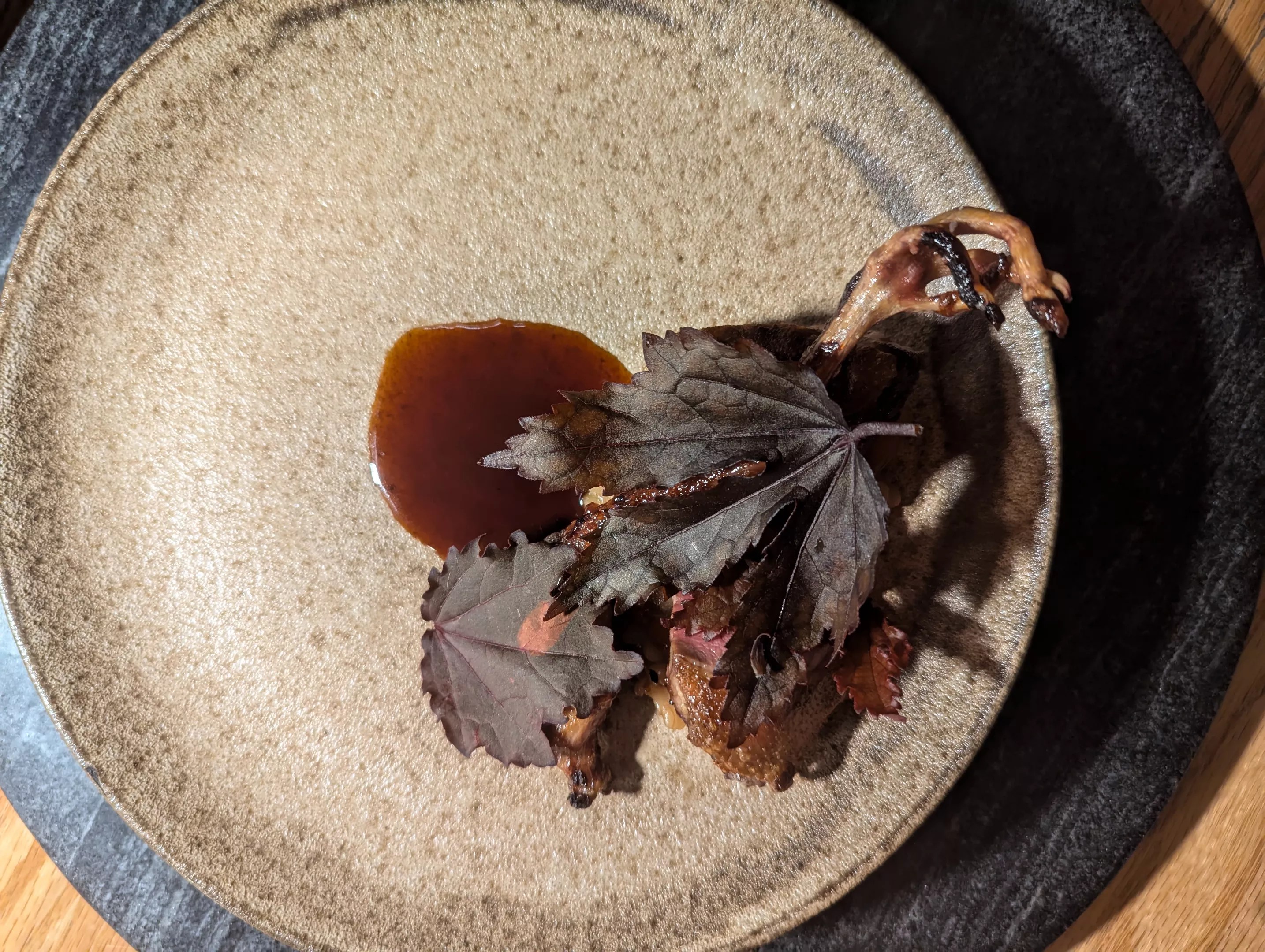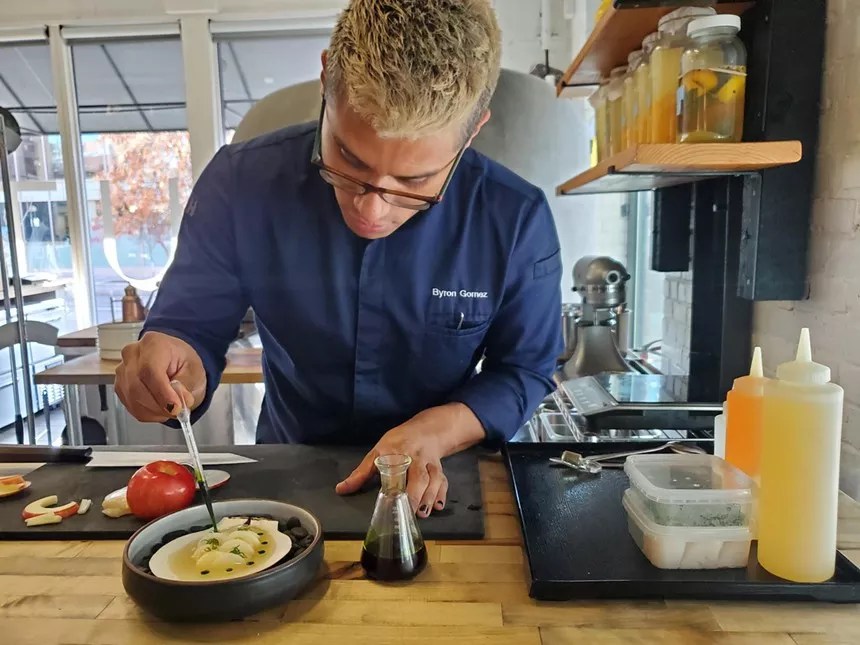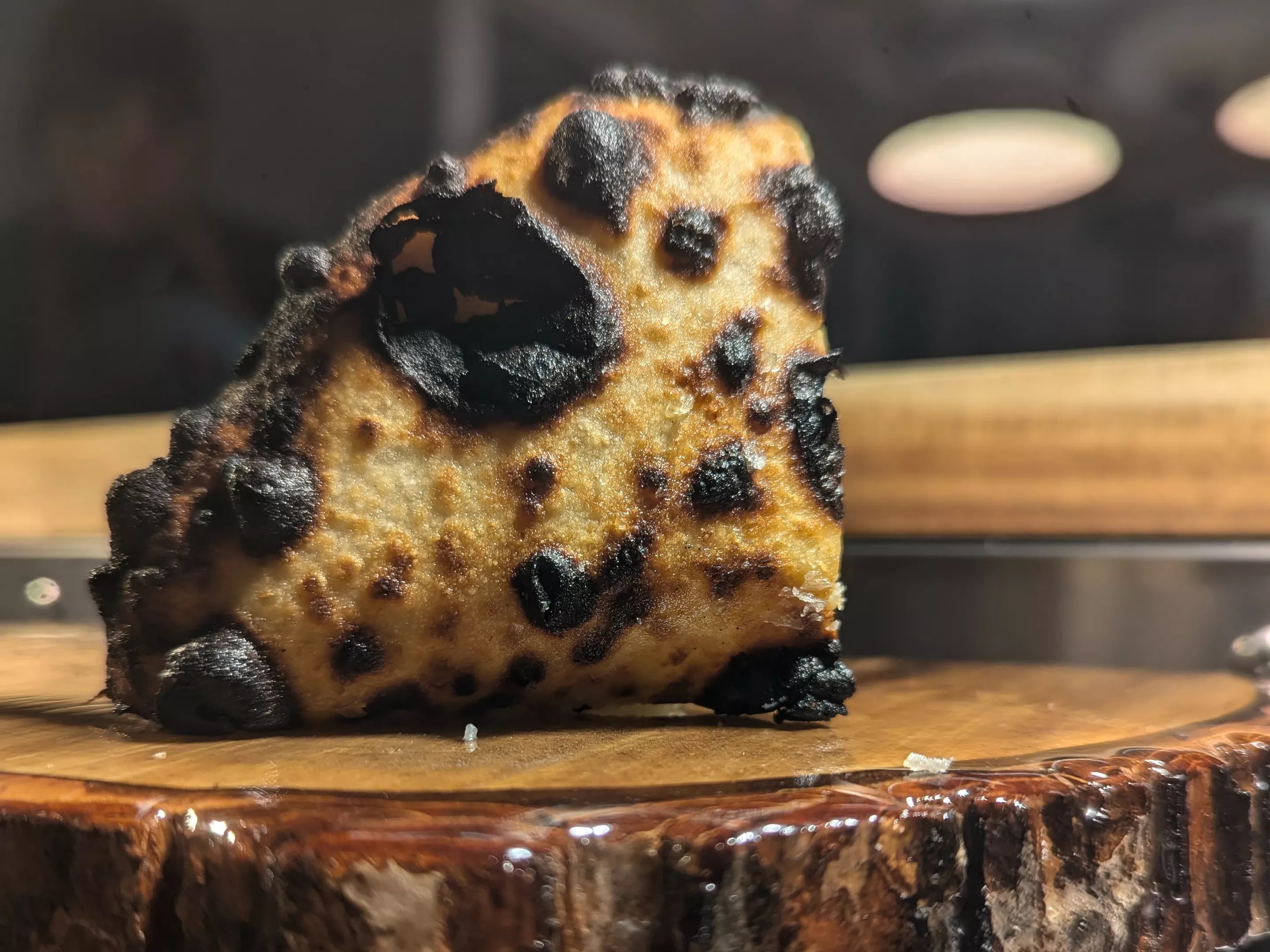
Jake Browne

Audio By Carbonatix
As someone who grew up eating microwaved dinners set to the Roseanne theme song, the idea of two people paying $755 for a dinner seems fucking insane. It’s gauche to even discuss what a dinner costs. For our two-year wedding anniversary, I wanted to show my wife I was less Dan Connor and more Daniel Craig. I wanted to whisk her off to a Michelin-starred restaurant for our version of The Bear‘s “Forks,” arguably the best piece of culinary TV ever created about fine dining. I wanted a lot of things.
Instead, we ate the culinary equivalent of Don’t Look Up – an entertaining meal that was thirty minutes too long and a little too into itself.
We need to talk about BrutÁ¸.
For the uninitiated, welcome: You’re part of a large cohort of Denverites that seemingly knows nothing about one of the most famous restaurants in our city – one of only three in Denver to earn a Michelin star when the tire company released its first Colorado guide last year. Two of those, BrutÁ¸ and the Wolf’s Tailor, come from the Id Est Hospitality Group; its founders, Kelly and Erika Whitaker, won Best Restaurateur at this year’s James Beard Awards.
Denver, make your New Year’s Resolution Count!
We’re $17,500 away from our End-of-Year campaign goal, with just a five days left! We’re ready to deliver — but we need the resources to do it right. If Westword matters to you, please contribute today to help us expand our current events coverage when it’s needed most.
Even our server, Alan, who recently celebrated his third year at the intimate LoDo space, acknowledges that the Michelin star came out of nowhere. “We didn’t really advertise or do a lot on social media,” Alan says.
You might hear whispers, though, of former executive chef Michael Diaz de Leon’s progressive, sustainable takes on dishes from across Mexico. You might visit its now-thoroughly oblique website, fresh out of a Kafka novel, which mentions “brutalism” multiple times. You might hunt Google Images for a recent seasonal menu, cursing at months gone by under your breath.
None of those things are BrutÁ¸.

Byron Gomez took the helm at Brutø in February.
Molly Martin
New executive chef and Top Chef alum Byron Gomez, who took over after Diaz de Leon left following the Michelin accolade, has kept the lacto-fermentation and “never put anything in the trash” aesthetic, but the August menu deeply lacks focus and cohesion.
One minute you’re enjoying the flavors of India and Mexico with the curry potato dumpling topped with macha chile in a rasam broth. The next you’re in Russia by way of Costa Rica, with awkwardly cut hearts of palm over a potato purée, topped with pickled pearl onions and Eco-certified, Sustainable, Responsibly Acquired Tsar Nicolai caviar. Diaz de Leon’s odes to masa and chiles are nowhere to be found.
There is nothing brutal here. I assume the squab we’re served passed away during particularly pleasurable intercourse, because every dish comes with a brief TED Talk about how environmentally friendly and waste-free what we’re eating is. To be clear, that is something I admire, but sustainability is expensive. The cost of ensuring that every atom of a pea is represented across the totality of our meal is evident in the bill but creates dishes where an ingredient feels shoehorned in to make everyone feel emotionally satisfied, even if their palate is wanting for more.
Far too often, elements are presented in service of narrative rather than my mouth. Because we’re drinking Lars Williams’s sorghum-based spirit in the BrutÁ¸ Bloody Mary, puffed sorghum is incongruously placed on top of an underwhelming spot prawn. I don’t need a mousse made from scraps of hearts of palm. The stories do function as entertainment: Alan has our rapt attention as he describes Dominique Moreau’s “crystals and moon cycles” approach to witchy winemaking.

The bread at Brutø is a highlight.
Jake Browne
Michelin stars aren’t awarded for service, though.
Nor are they given for bread, against the protests of people like me and Oprah. The former Cinderella kitchen puts its “cinders” to work with its sourdough piada made with grains from Id Est’s own milling company, Dry Storage, and century-old starter courtesy of San Francisco bakery Tartine. It’s a transcendent, fluffy pocket, pocked with charred blisters that puts to shame the notion we can’t have nice gluten at altitude.
When you’re told during your $755 dinner (a price tag that includes drink pairings, service charges and optional gratuity) that you can purchase an extra order of bread to go, you don’t even ask the price, because you’re no longer sure if this is a joke or not.
So, what is BrutÁ¸? I’m not entirely sure, but I don’t think it’s still worthy of the one-star accolade bestowed upon it last year. For every divine shmear of ramp butter, there were issues like the macha chile, which had multiple inedible hard “chunks” in it. After much deliberation in the open kitchen, the consensus was they were parts of a pepper? I don’t know, either.

A dessert course of vanilla-koji ice cream that’s meant to resemble the coals in Brutø’s chiminea.
Jake Browne
While BrutÁ¸ is absolutely deserving of retaining its green star for sustainability practices, I wonder how much that focus works to the restaurant’s detriment. I’m not advocating for it to go full Lanford Lunch Box here and start slinging loose meat sandwiches, but the fictional mom-and-pop was a restaurant that knew what it was and cooked to its strengths.
BrutÁ¸ feels like a restaurant that’s still finding its footing under Gomez, only one leg is tied to a myriad of eco-aware practices that bog down the menu. The key to winning a three-legged race isn’t going fast, but syncing up. Right now BrutÁ¸ is stumbling. Hopefully, it can recover and come back strong.